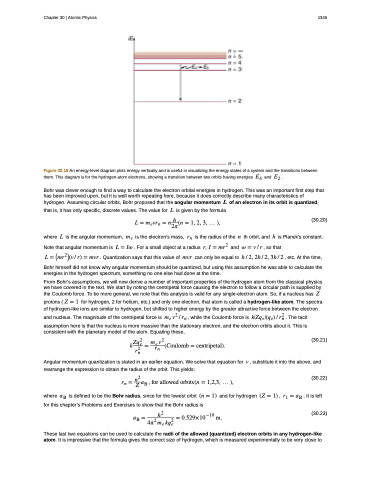Page 1357 - College Physics For AP Courses
P. 1357
Chapter 30 | Atomic Physics 1345
Figure 30.18 An energy-level diagram plots energy vertically and is useful in visualizing the energy states of a system and the transitions between them. This diagram is for the hydrogen-atom electrons, showing a transition between two orbits having energies �� and �� .
Bohr was clever enough to find a way to calculate the electron orbital energies in hydrogen. This was an important first step that has been improved upon, but it is well worth repeating here, because it does correctly describe many characteristics of hydrogen. Assuming circular orbits, Bohr proposed that the angular momentum � of an electron in its orbit is quantized,
that is, it has only specific, discrete values. The value for � is given by the formula
� � ����� � � � �� � �� �� �� � �� (30.20)
��
where � is the angular momentum, �� is the electron’s mass, �� is the radius of the � th orbit, and � is Planck’s constant.
Note that angular momentum is � � �� . For a small object at a radius �� � � ��� and � � � � � , so that
� � ��������� � �� � ��� . Quantization says that this value of ��� can only be equal to � � �� �� � �� �� � � , etc. At the time,
Bohr himself did not know why angular momentum should be quantized, but using this assumption he was able to calculate the energies in the hydrogen spectrum, something no one else had done at the time.
From Bohr’s assumptions, we will now derive a number of important properties of the hydrogen atom from the classical physics we have covered in the text. We start by noting the centripetal force causing the electron to follow a circular path is supplied by the Coulomb force. To be more general, we note that this analysis is valid for any single-electron atom. So, if a nucleus has �
protons ( � � � for hydrogen, 2 for helium, etc.) and only one electron, that atom is called a hydrogen-like atom. The spectra
of hydrogen-like ions are similar to hydrogen, but shifted to higher energy by the greater attractive force between the electron
and nucleus. The magnitude of the centripetal force is �� �� � �� , while the Coulomb force is ������������ � ��� . The tacit
assumption here is that the nucleus is more massive than the stationary electron, and the electron orbits about it. This is consistent with the planetary model of the atom. Equating these,
����� � �� ���������� � ������������� (30.21) � �� � �
Angular momentum quantization is stated in an earlier equation. We solve that equation for � , substitute it into the above, and rearrange the expression to obtain the radius of the orbit. This yields:
�� � ���� � ��� ������� �������� � ������ � �� (30.22) �
where �� is defined to be the Bohr radius, since for the lowest orbit �� � �� and for hydrogen �� � �� , �� � �� . It is left for this chapter’s Problems and Exercises to show that the Bohr radius is
�� � �� � ����������� �� (30.23) ��� �� ����
These last two equations can be used to calculate the radii of the allowed (quantized) electron orbits in any hydrogen-like atom. It is impressive that the formula gives the correct size of hydrogen, which is measured experimentally to be very close to


